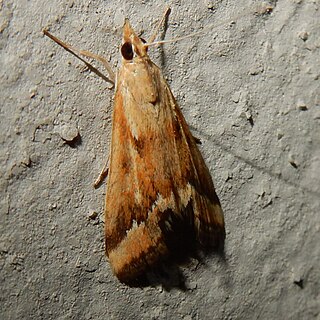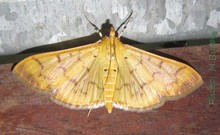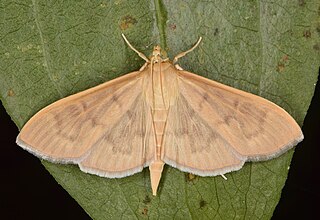Mabra is a genus of moths of the family Crambidae. It is placed in the tribe Portentomorphini of the subfamily Pyraustinae. The nine species of the genus are mainly distributed in tropical Asia, but M. metallescens and M. russoi are found in tropical Central and South America.

Patania is a genus of moths of the family Crambidae described by Frederic Moore in 1888.

The Chrysauginae are a subfamily of snout moths. They are primarily Neotropical and include about 400 described species.

Glyphodes negatalis, the karanj defoliator, is a moth of the family Crambidae. The species was first described by Francis Walker in 1859. It has a wide range in the tropics, including South Africa, The Gambia, Mali, India, Sri Lanka, Hong Kong, Japan, and eastern Australia.

Gesonia obeditalis is a species of moth of the family Noctuidae first described by Francis Walker in 1859. It is found from eastern Africa, the Seychelles, the Maldives and the Oriental tropics of India, Myanmar, Sri Lanka east to the Philippines, the Sula Islands and Australia. The adult moth has brown wings with a scalloped dark brown band near the margin. The hindwings are similar in pattern to the forewings but are a paler shade of brown.

Cydalima perspectalis or the box tree moth is a species of moth of the family Crambidae, first described by Francis Walker, the English entomologist, in 1859. Native to Japan, China, Taiwan, Korea, far-east Russia and India, it has invaded Europe; first recorded in Germany in 2006, then Switzerland and the Netherlands in 2007, Great Britain in 2008, France and Austria in 2009, Hungary in 2011, then Romania, Spain and Turkey. It has been seen in Slovakia, Belgium and Croatia.

Pyrausta phoenicealis, the perilla leaf moth, is a moth of the family Crambidae described by Jacob Hübner in 1818. It is found worldwide, including the Americas, Africa, Australia and Asia.

Parapoynx crisonalis is a moth in the family Crambidae. It was described by Francis Walker in 1859. It has a wide range and has been recorded from India, Sri Lanka, Thailand, Indonesia, China, Taiwan, Japan and Australia (Queensland). It has been recorded from Great Britain through accidental import with aquatic plants.

Achyra coelatalis is a species of moth in the family Crambidae. It was described by Francis Walker in 1859. It is found in Botswana, the Democratic Republic of the Congo, Ghana, Kenya, Réunion, Lesotho, Madagascar, Namibia, Niger, the Seychelles, South Africa, Tanzania, Zambia, Zimbabwe, Australia, India and Sri Lanka.
Bicilia iarchasalis is a moth in the family Crambidae. It was described by Francis Walker in 1859. It is found in the south-eastern United States, where it has been recorded from Florida and Texas, as well as in Mexico, Cuba, the Dominican Republic, Puerto Rico and Venezuela.

Nacoleia charesalis is a moth in the family Crambidae. It was described by Francis Walker in 1859. It is found in Australia, India, Sri Lanka, Borneo, Sumbawa, the Philippines, Singapore, Thailand, Japan, Taiwan and on the Seychelles.
Herpetogramma stultalis is a moth in the family Crambidae. It was described by Francis Walker in 1859. It is found in Malaysia, India, Sri Lanka, China, Japan, Pakistan, Papua New Guinea and Australia, where it has been recorded from Queensland. In Africa, it has been recorded from the Democratic Republic of the Congo and Réunion.
Omiodes poeonalis is a moth in the family Crambidae. It was described by Francis Walker in 1859. It is found in the Democratic Republic of the Congo, Sierra Leone, Tanzania, the Chagos Archipelago, China, Indonesia, Sri Lanka, Japan and Australia (Queensland).

Patania balteata is a species of moth of the family Crambidae. It was described by Johan Christian Fabricius in 1798. It is found across southern Europe, Africa and Asia, including Japan, Korea, Réunion, Madagascar, Taiwan, Thailand, Turkey and Ukraine, as well as New South Wales and Queensland in Australia. There is also an old record from Hawaii.

Patania sabinusalis is a species of moth in the family Crambidae. It was described by Francis Walker in 1859. It is found in Australia, Cameroon, the Democratic Republic of the Congo, Kenya, the Seychelles, Somalia, Uganda, Zambia, Sri Lanka, India, Borneo, Java, Fiji, New Guinea, Samoa, the Solomon Islands, Taiwan and Japan.

Patania scinisalis is a species of moth in the family Crambidae. It was described by Francis Walker in 1859. It is found in the Himalayas, India (Assam), Myanmar, Taiwan and Japan.

Patania silicalis, commonly known as the herbivorous pleuroptya moth, is a species of moth in the subfamily Spilomelinae of the family Crambidae. It was described by Achille Guenée in 1854. It is found in Brazil, Venezuela, Ecuador, French Guiana, Guyana, Guatemala, Costa Rica, Panama, Mexico, Cuba, Jamaica, Puerto Rico, Hispaniola and the United States, where it has been recorded from Missouri, Michigan, Ohio and New York, south to Florida.

Hydrillodes gravatalis is a moth of the family Erebidae first described by Francis Walker in 1859. It is found in the Indian subregion, Sri Lanka and Sundaland.

Margaroniini is a tribe of the species-rich subfamily Spilomelinae in the pyraloid moth family Crambidae. The tribe was erected by Charles Swinhoe and Everard Charles Cotes in 1889, originally as family Margaronidae.














